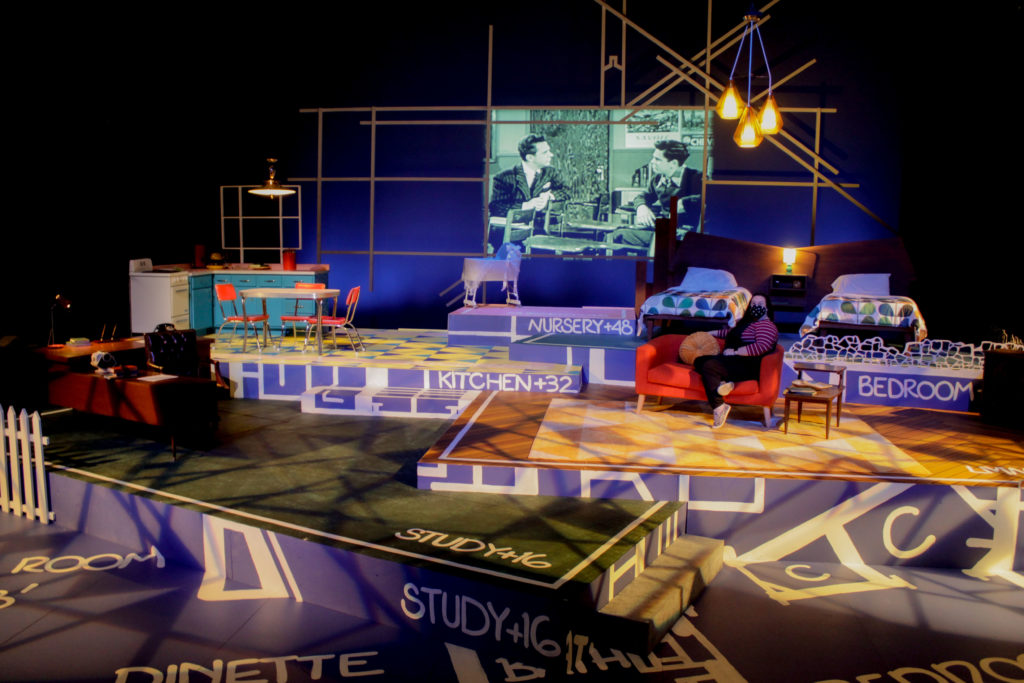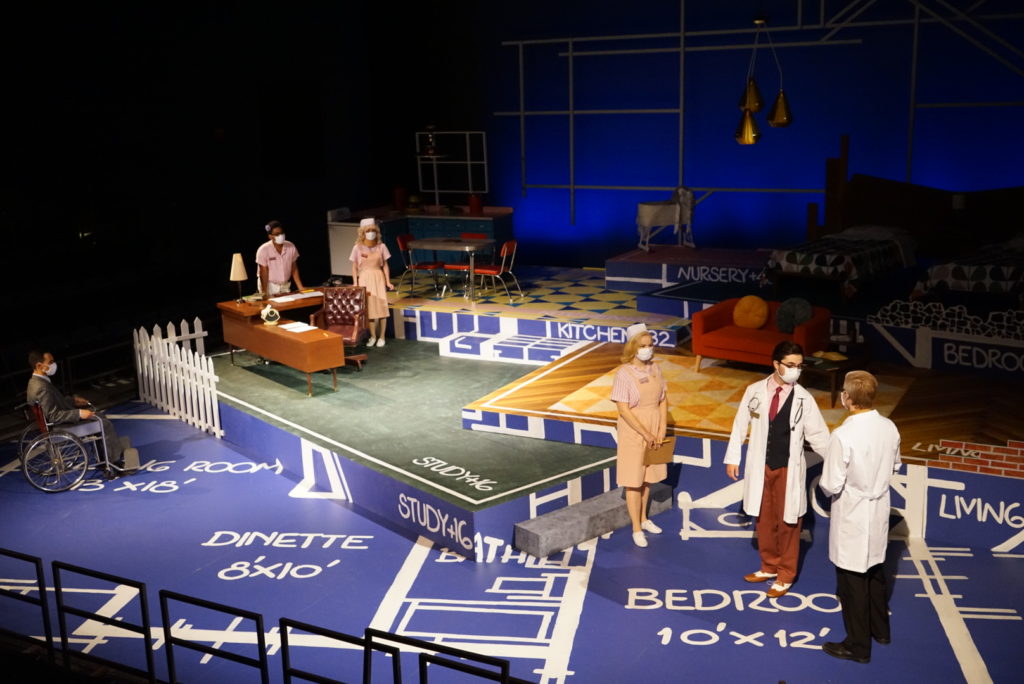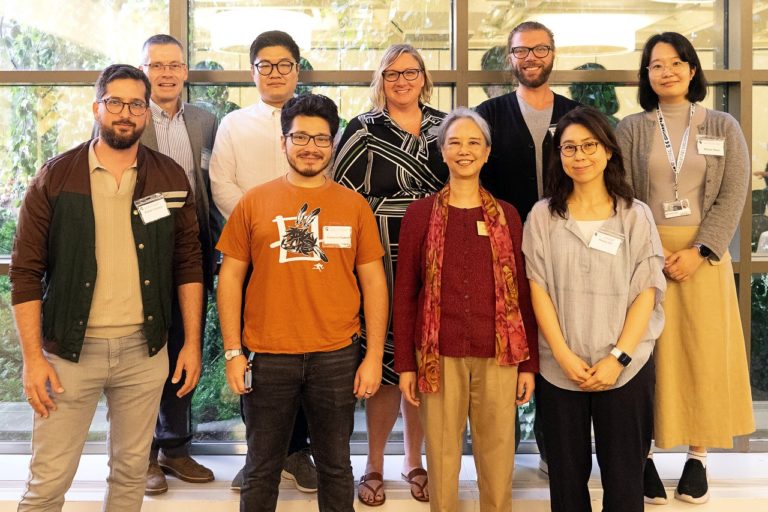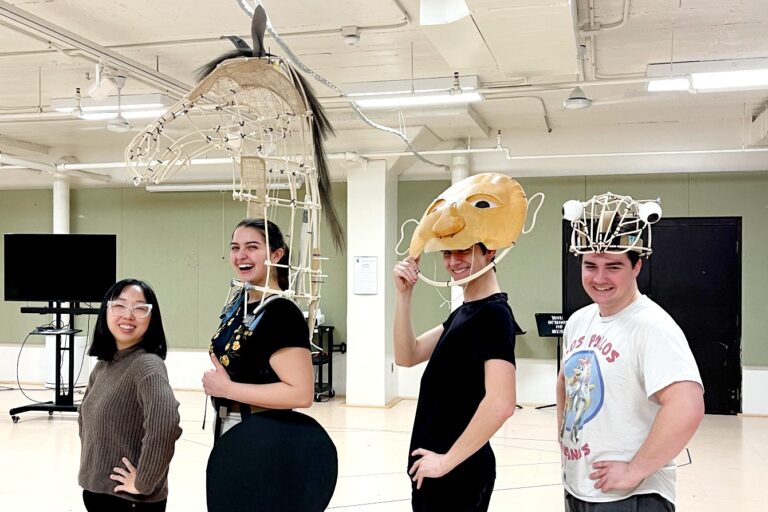Two MFA Design Candidates from Michigan State University, Kasee Arnett and Zech Saenz, recently won awards at the Kennedy Center American College Theater Festival (KCACTF) Region III competition for their work on A Contemporary American’s Guide to a Successful Marriage. Arnett took first place in Scenic Theatrical Design and will move on to the national competition, and Saenz finished as a runner-up in Costume Design.
“It was a complete shock, and it was just such a good feeling,” Arnett said about learning she had come in first place. “I feel truly blessed and so honored to have such an opportunity like this. I didn’t think I would get that far. It was a great moment.”

KCACTF is a national theater program involving 18,000 students from colleges and universities across the country. The competition began with eight regional festivals, which were held virtually this year. The first-place winners of the regional competitions, including Arnett, now move on to the national competition. Winners of the National Competition will be announced virtually on Saturday, May 21.
Arnett credits the excellent production and technical teams she worked with at MSU’s Scene Shop for helping her earn this award.
“It was a complete shock, and it was just such a good feeling. I feel truly blessed and so honored to have such an opportunity like this. I didn’t think I would get that far. It was a great moment.”
Kasee Arnett
“They were such a cohesive and positive influence on me,” she said. “We had the best time building the show. And that’s what it’s really about – if you have people you enjoy and love to work with, it makes the experience worth it. You’ll be successful no matter what if you have a positive experience collaborating.”
KCACTF Competition
During the KCACTF competition, participants discussed their designs in front of a panel of judges. The competition began with a round of two-minute presentations followed by eight minutes of questions and comments from the judges and other participants. Those who make it to the second round were asked to do a four-minute presentation, wherein they had the chance to explain their design in more detail and depth, followed by 10 minutes of questions.
“Since we were so limited in that first round, we tried to get out our concepts and the process of the design, and the next round gave us a little more time to sneak in some background about the play itself,” Arnett said. “It doesn’t really matter if the play is well known or not because they look at how we collaborate with others, how we design, how we think as an artist, and our process of going through a play.”

Participants were a mix of undergraduate and graduate students. Some arrived at the competition with material from a class project or fully realized show and others with unrealized work from shows canceled because of COVID.
“It’s a range of people, and it was a fun time,” Arnett said.
Arnett has attended KCACTF twice so far, and this was her first time experiencing the festival virtually. She found the new format made it much easier to present.
“We had the best time building the show. And that’s what it’s really about – if you have people you enjoy and love to work with, it makes the experience worth it. You’ll be successful no matter what if you have a positive experience collaborating.”
Kasee Arnett
“Being online was a lot more helpful to me than the first time I went, which was just so nerve-racking. You’re just standing there and you’re watching the judges bounce around, and you know they’re coming, and that just makes you even more nervous,” she said. “But with Zoom, you can just relax in your own home and not have all that pressure on you. It was kind of relieving to me.”
That said, Arnett said she hopes the national competition will be held in person.
“It’s a once-in-a-lifetime experience. And I’ve heard a lot of fun things go on during that time and you get exposure to so many things,” she said. “I’ve also never been to Washington, D.C., before, so that would be an experience on its own to me.”
Scenic Theatrical Design
Arnett describes Scenic Theatrical Design as “basically the set of a play.”
“We’re creating the atmosphere for a play, much like how you see sets on movies, and things in the world around them,” she said. “It’s very similar, but we’re on a stage instead of in a movie.”
Arnett’s design process has changed somewhat over the years, especially as she’s come into her own as an artist and creator, but it always starts the same way by reading the script. And then reading the script again and again until the different layers and themes have been picked out and she has a solid idea of what she’s working with.

“When I first get a design, I obviously read the script first to see what the plot and characters are like. And then that second time I read for design elements and things like that to help me start visualizing,” she said. “I read the play so many times because there’s so many hidden messages and little things you don’t catch the first couple of times. It’s good to go back and analyze.”
Theater is an inherently collaborative medium. Designers meet with the director and their peers during the beginning of production. The director shares their vision and concept of the play, and other designers contribute their own ideas and inspirations. From there, the group begins to discuss how they can collaborate to mesh their different perspectives together. This is followed by sketching – “millions of sketches,” as Arnett puts it – and detailed research. The group meets again, and each designer receives feedback from their peers and the director. This collaboration continues until the group has a solid idea of the world they want to create and believes that it will feel persuasive and immersive for their audience.
As the Scenic Theatrical Designer, Arnett then creates a white model, a small-scale mockup that helps give the director a better understanding of how to block and stage the play. She then drafts the set of the play and sends the blueprints to the Scene Shop.
“All the other design elements depend so much on scenery,” she said, “you really have to be the first one to get done.”
Award-Winning Design
Arnett initially approached her designs for A Contemporary American’s Guide to a Successful Marriage very literally.
“I kept trying to put an exact replica of a 1950s modular home on stage,” she said. “The director was easing me into going more abstract with it. I did more research and then came across these 1950s modular homes blueprints. One of his premises was peeling away the reality of marriage, and I thought, ‘What does it look like when you peel away at a house and you get to the core?’ It’s so cool how everything ties together from the front of the stage all the way to the back. It’s just that blueprint bleeding all the way through. And it’s this cool, abstract, different design. I get so excited whenever I see it because it’s so unique.”
“The equivalent of a blueprint for clothing is paper patterns. So my director and I decided to make the characters paper dolls in a way to communicate the idea of people breaking free of commercialism and societal norms.”
Zech Saenz
The idea of using blueprints to strip away the reality of things also was incorporated into other areas of the play, including the costumes.
“The equivalent of a blueprint for clothing is paper patterns. So my director and I decided to make the characters paper dolls in a way to communicate the idea of people breaking free of commercialism and societal norms,” Saenz said about his runner-up winning costume designs.

Arnett’s award in Scenic Design Theatrical Design represents a major milestone in her journey as an artist. In the past, she says she struggled with her perception of herself as an artist, often considering others to be better than her. Recently, however, that perception has begun to change.
“I thought I should at least try and compete and see what happens,” she said. “I don’t really care if I win or lose – the experience is mainly what I care about. I did it, and it’s been such a nice experience because I’m proving to myself I can do things, that the stuff I do is awesome.”


